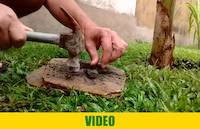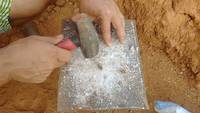Prospecting for gold in rocks
Prospecting for gold in rocks is a basic procedure that each prospector shall know and use. Whenever there is alluvial gold found, one shall also prospect for gold in rocks.
The lode gold is the original gold and usually found in rocks. Such gold is not yet liberated from other minerals.
Prospecting for gold in rocks is easy.
Follow this simple procedure as advised by Mr. Jean Louis in the program Start Your Own Gold Mine:
Find some proper hard surface on which you may crush the rocks which you wish to check for gold. Also obtain a hammer. It is advisable that you use clean, plastic bags, to cover the rocks while crushing in order to protect yourself. Further, eyes-protection such as goggles and hand gloves may be also necessary for safety. Instead of the hard surface and hammer, most advisable would be to use a proper mortar and pestle. You will also need a basin, gold pan and clean water. A kitchen sifter is also recommended. Hand lens or magnifier is a must to see the invisible or fine gold particles.
Be sure to use the dark metal hammer. Do not use any metals which are of yellow colors. Once we were using a brass made mortar and pestle. Small particles of brass were mixed with the rock content then giving the impression that gold was found in rocks. Avoid using brass metal in rock prospecting.
Before crushing the rock, always wash the rock itself, the hammer, and the surface you are using as it may contain some gold particles from previous rocks. You do not wish to salt your rock dust with some particles of previous test.
Put the rocks either in the mortar and pestle, or wrap them in the clean plastic bags, or simply crush the rock with the hammer on the hard surface.
Carefully transfer the crushed material into the gold pan. It is advisable to use the kitchen sifter or gold prospecting sieves to discard all the larger particles. Be sure to wash just all the particles from the surface where rock was crushed into the gold pan. Gold particles being heaviest are going to remain on the surface and you may miss them if you do not take them all into the gold pan.
Proceed with gold panning and try to find the gold. And if not gold, you may find other precious metals or at least black sand. Gold panning techniques are explained in widely known literature and shown on numerous videos online.
Once you finish panning and reduce the minerals down to small amount use the hand lens or magnifier to search for smallest particles.
Collect the samplest into vials. If you find any other heavier minerals, collect them as well.
Always record your exact location by using your GPS that is usually built into the mobile devices. Describe your position well on the paper, and reference the vials with your samples of gold or other minerals found correctly so that you may later know where you found what.
Related pages
- Prospecting for gold in rocks
 Follow this simple procedure as advised by Mr. Jean Louis in the program Start Your Own Gold Mine: 1. Find some proper hard surface on which you may crush the rocks which you wish to check for gold. Also obtain a hammer. It is advisable that you use clean, plastic bags, to cover the rocks while crushing in order to protect yourself. Further, eyes-protection such as goggles and hand gloves may be also necessary for safety. Instead of the hard surface and hammer, most advisable would be to use a proper…
Follow this simple procedure as advised by Mr. Jean Louis in the program Start Your Own Gold Mine: 1. Find some proper hard surface on which you may crush the rocks which you wish to check for gold. Also obtain a hammer. It is advisable that you use clean, plastic bags, to cover the rocks while crushing in order to protect yourself. Further, eyes-protection such as goggles and hand gloves may be also necessary for safety. Instead of the hard surface and hammer, most advisable would be to use a proper… - Prospecting for gold in rocks
 Prospecting for gold in rocks is a basic method and shall be foundation for every prospector. Some of gold prospectors are focusing only on alluvial and liberated gold and forget that such may be coming from rocks. And often rocks contain richer gold grade then alluvial soil. There are few simple and practical methods for prospecting for gold in rocks. In this category of Start Your Own Gold Mine, we are explaining methods and showing you videos on how to prospect for gold in rocks.
Prospecting for gold in rocks is a basic method and shall be foundation for every prospector. Some of gold prospectors are focusing only on alluvial and liberated gold and forget that such may be coming from rocks. And often rocks contain richer gold grade then alluvial soil. There are few simple and practical methods for prospecting for gold in rocks. In this category of Start Your Own Gold Mine, we are explaining methods and showing you videos on how to prospect for gold in rocks. - Crushing rocks while prospecting for gold
 Rocks are being crushed while prospecting for gold. Metallic surface may be used or other larger rock surfaces. Care shall be taken to carefully wash the surface, the hammer, including the rocks to be crushed and basin and gold pans so to avoid the salting with previous gold particles. Artisanal miners in this area were of the opinion that rocks need to be dried before crushing, that is not true, and with the care you may crush even quartz without rocks flying everywhere around. Keep your eyes safe…
Rocks are being crushed while prospecting for gold. Metallic surface may be used or other larger rock surfaces. Care shall be taken to carefully wash the surface, the hammer, including the rocks to be crushed and basin and gold pans so to avoid the salting with previous gold particles. Artisanal miners in this area were of the opinion that rocks need to be dried before crushing, that is not true, and with the care you may crush even quartz without rocks flying everywhere around. Keep your eyes safe…

